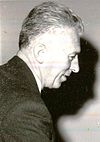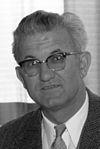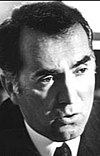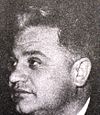
Yugoslavia was a country in Southeast and Central Europe that existed from 1918 to 1992. It came into existence following World War I, under the name of the Kingdom of Serbs, Croats and Slovenes from the merger of the Kingdom of Serbia with the provisional State of Slovenes, Croats and Serbs, and constituted the first union of South Slavic peoples as a sovereign state, following centuries of foreign rule over the region under the Ottoman Empire and the Habsburg monarchy. Peter I of Serbia was its first sovereign. The kingdom gained international recognition on 13 July 1922 at the Conference of Ambassadors in Paris. The official name of the state was changed to Kingdom of Yugoslavia on 3 October 1929.
The Anti-Fascist Council for the National Liberation of Yugoslavia, commonly abbreviated as the AVNOJ, was a deliberative and legislative body that was established in Bihać, Yugoslavia, in November 1942. It was established by Josip Broz Tito, the leader of the Yugoslav Partisans, an armed resistance movement led by the Communist Party of Yugoslavia to resist the Axis occupation of the country during World War II.

The president of the Socialist Federal Republic of Yugoslavia was the head of state of that country from 14 January 1953 to 4 May 1980. Josip Broz Tito was the only person to occupy the office. Tito was also concurrently President of the League of Communists of Yugoslavia. Tito was eventually declared president for life and with his death in 1980 the office was discontinued and the new office of President of the Presidency of Yugoslavia took its place.
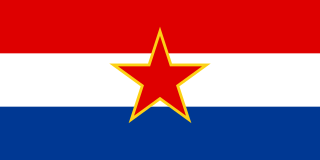
The Socialist Republic of Croatia, commonly abbreviated as SR Croatia and referred to as simply Croatia, was a constituent republic and federated state of the Socialist Federal Republic of Yugoslavia. By its constitution, modern-day Croatia is its direct continuation.
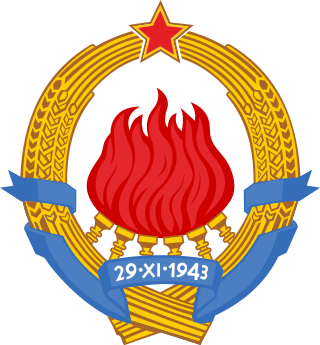
The president of the Federal Executive Council was the head of government of the Socialist Federal Republic of Yugoslavia, from the adoption of the 1963 constitution until the complete breakup of the country in 1992. Most non-Yugoslav sources referred to the post as "Prime Minister."

The prime minister of Yugoslavia was the head of government of the Yugoslav state, from the creation of the Kingdom of Serbs, Croats and Slovenes in 1918 until the breakup of the Socialist Federal Republic of Yugoslavia in 1992.

The Socialist Republic of Serbia, previously known as the People's Republic of Serbia, commonly abbreviated as Republic of Serbia or simply Serbia, was one of the six constituent republics of the Socialist Federal Republic of Yugoslavia in what is now the modern day states of Serbia and the disputed territory of Kosovo. Its formation was initiated in 1941, and achieved in 1944–1946, when it was established as a federated republic within Yugoslavia. In that form, it lasted until the constitutional reforms from 1990 to 1992, when it was reconstituted, as the Republic of Serbia within the Federal Republic of Yugoslavia. It was the largest constituent republic of Yugoslavia, in terms of population and territory. Its capital, Belgrade, was also the federal capital of Yugoslavia.

The Presidency of the Socialist Federal Republic of Yugoslavia was the collective head of state of the Socialist Federal Republic of Yugoslavia. It was established in 1971 according to amendments to the 1963 Constitution and reorganized by the 1974 Constitution. Up to 1974, the Presidency had 23 members – three from each republic, two from each autonomous province and President Josip Broz Tito. In 1974 the Presidency was reduced to 9 members – one from each republic and autonomous province and, until 1988, President of the League of Communists of Yugoslavia ex officio.

The Order of the Yugoslav Star was the highest national order of merit awarded in Yugoslavia. It was divided into four classes. The highest class, the Yugoslav Great Star was the highest state decoration awarded in Yugoslavia. The order was mostly awarded to foreign heads of state for the development and strengthening of peace and cooperation between nations.

Avdo Humo was a Yugoslav and Bosnian communist politician, writer and an Order of the People's Hero recipient.

The 1946 Yugoslav Constitution, officially titled as the Constitution of the Federal People's Republic of Yugoslavia, was the first constitution of the Federal People's Republic of Yugoslavia. It was adopted by the Constitutional Assembly of Yugoslavia, elected on 11 November 1945. Constitution came into effect at its promulgation, on 31 January 1946.

The 1974 Yugoslav Constitution was the fourth and final constitution of the Socialist Federal Republic of Yugoslavia. It came into effect on 21 February 1974.
Dušan Bilandžić was a Croatian historian and politician.

The president was the leader of the League of Communists of Montenegro (LCM), the ruling party of the Socialist Republic of Montenegro (SRM) in the Socialist Federal Republic of Yugoslavia. Party rules stipulated that the LCM Central Committee elected the president. Moreover, the Central Committee was empowered to remove the president. The president served ex officio as a member of the Presidency of the Central Committee of the League of Communists of Yugoslavia (LCY) and of the SRM Presidency. To be eligible to serve, the president had to be a member of the Presidency of the LCM Central Committee. The 8th LCM Congress instituted a two-year term limits for officeholders.

The office of vice president of the Socialist Federal Republic of Yugoslavia existed from April 1963 to June 1967. It was established by the new Yugoslav Constitution adopted on 7 April 1963. The first to serve in the role was Aleksandar Ranković who assumed office on 30 June 1963. Due to an affair involving wire-tapping of Yugoslav president and general secretary of the League of Communists Josip Broz Tito, Ranković was forced to resign from the Central Committee and from the vice presidency on 1 July 1966. He was subsequently replaced by Koča Popović two weeks later who served out the remainder of Ranković's four-year term. On 26 April 1967 new amendments to the 1963 constitution were approved which disestablished the vice presidency once Ranković and Popović's combined four-year term was up. The office ceased to exist on 30 June 1967.

The office of the vice president of the Presidency of the SFR Yugoslavia existed from the enactment of constitutional amendments establishing the position in 1971 until the dissolution of the country by 1992. A collective presidency existed in Yugoslavia since amendments to the constitution in 1971. The amendments established the roles of President and Vice President within the collective Presidency which would rotate between individual republics and provinces on an annual basis. However, it also defined a separate title of President of the Republic which could be conferred by the Federal Assembly into Josip Broz Tito who would automatically preside over the Presidency as well. Therefore, the launch of the Vice Presidency of the Presidency in 1971 would be the first to carry out a rotation system. Krste Crvenkovski of SR Macedonia was the first to hold the office. The subsequent order after SR Macedonia was SR Bosnia and Herzegovina, SR Slovenia, SR Serbia, SR Croatia, SR Montenegro, SAP Vojvodina, and SAP Kosovo. In 1974 a new Constitution was adopted which reaffirmed the collective federal presidency consisting of representatives of the six republics, the two autonomous provinces within Serbia and the President of the League of Communists.

The office of the president of the presidency of the Socialist Republic of Serbia existed from its establishment in the 1974 constitution to its renaming and then total abolishment as part of democratic reforms in 1990.
The Socialist Republic of Croatia, one of the constituent countries of the Socialist Federal Republic of Yugoslavia had gone through a number of phases in its political life, during which its major political characteristics changed - its name, its top level leadership and ultimately its political organization.


